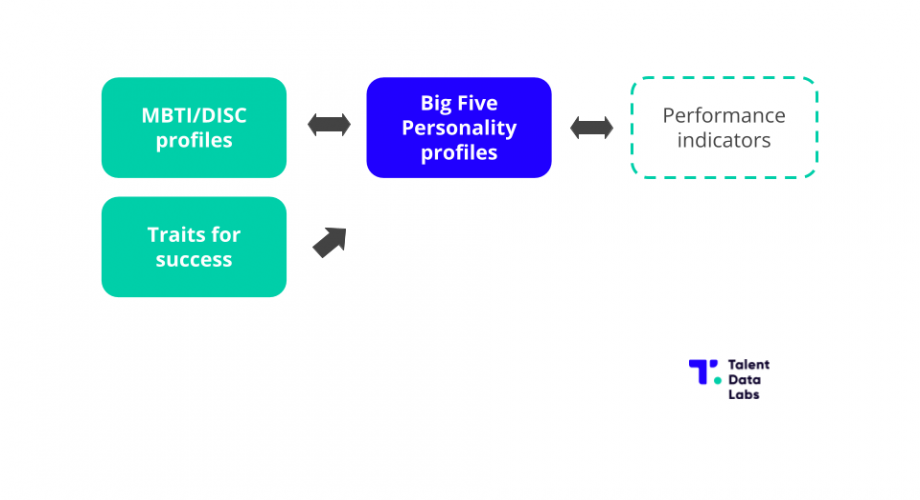
Recommendations for using DISC and MBTI profiles in hiring
If you have spent enough time in any (corporate) environment you must have been confronted with either a DISC or MBTI assessment or maybe both. Some of your analysts may have been labeled Blue or are maybe more Orange? How about your sales team are they all ESFJ’s or do you have more ISFJ’s?
These labels may come in incredibly handy when looking for traits you associate with success and performance. In my time I have heard phrases like: “if you want to be good in door-to-door sales you must be at least 60% red” and “our analysts are all blue because they care mostly about goals rather than people”. These statements are considered nonsensical in most scientific communities (read more about some of the problems here). However, in our professional opinion, these statements can be incredibly useful and we will tell you why.
People are pretty good at understanding performance.
When we dive into the literature we find that we’re pretty good at measuring and assessing performance. This means that we intuitively understand when someone is good or bad at something. We are also very good at associative thinking (D. Kahneman wrote an excellent book about it). In short associative thinking is an efficient tool for our brain to store information in groups and clusters of similar and related things. If we think about good salespeople we may think about great listeners or maybe we even think about on-stage performances or actors.
The associative mind allows us to connect high-performing sales with certain traits such as negotiation skills. These associations are typically simplified and a bit biased but not necessarily completely inaccurate. If your organization is certain that a good deal of Extraverted behavior and Assertiveness is needed to sell your goods then it will be very likely that your sales staff shows up as “Red (DISC)” or “Extraverted (MBTI)”. There are some complicated mental mechanisms that make this possible (confirmation bias). So even though these tests are not very accurate and even though the profiles aren’t very useful for screening they do give us an interpretation of what is important for success in an organization. If you go back to your old MBTI results you have somewhere you can probably handpick two or three traits that are considered most important in your co-workers and yourself.
If you know what success looks like you can find it in other places.
Imagine that - thanks to MBTI and DISC - we have a pretty good idea of what drives performance, you probably already have a list in mind of things that matter most in your team. All we need now is a valid tool to understand people before you throw them into the deep (make them do their jobs).
Unfortunately, as mentioned above neither MBTI nor DISC will be any good at screening or pre-screening (they even say so themselves on their websites). However, we do know of a tool that consistently performs as a great screening tool → the big five personality test (5-factor). We provide them ourselves but you can find some of these tests online easily by searching for it. The first step is to invite your entire team to take a five-factor personality test. Secondly, you should put all the data in excel or print their reports (or use our platform for easy management and grouping of people). The last step is getting together with your team and discussing the most important traits you see in both assessments.
Using the five-factor personality and the success profiles you have extracted from MBTI/DISC you can match the list of indicators that are good and bad. If you’re a real data wizard you can even add all the performance data you have gathered over time to see if higher traits lead to higher performance (or click here on our platform). That way you can actually see who has the native traits for success and who could use some support in developing them.
Keep in mind though that it is not only about hiring people with the right traits. If you’re ambitious it’s also about fostering and developing people for their diverse natures no matter what profile they have.
It’s not all about hiring
Keep in mind that not all companies have plenty of candidates to select from and others would like to have more diversity in their teams. You should see this as an opportunity to really apply yourself. Imagine that Extraversion is a really important trait for your sales team. Your sales team could greatly benefit from your support in onboarding people with low extraversion by giving them media or stage training and really getting them comfortable with all sorts of situations. This is where great HR managers and L&D leaders really shine. We have seen countless success cases with seemingly mismatching profiles that have been given a chance to succeed by great leaders. We have seen the most chaotic and unstructured analysts applying software and becoming more organized than anyone else in the organization and some of the best sales leaders come from the introverted talent pool. It’s never too late to take the next step in your people analytics journey.
Did you know that we also provide personality-based coaching, where we use your trait overview to help you collaborate and function effectively in a team environment? You can contact us directly or fill in the contact form on the website to learn more.